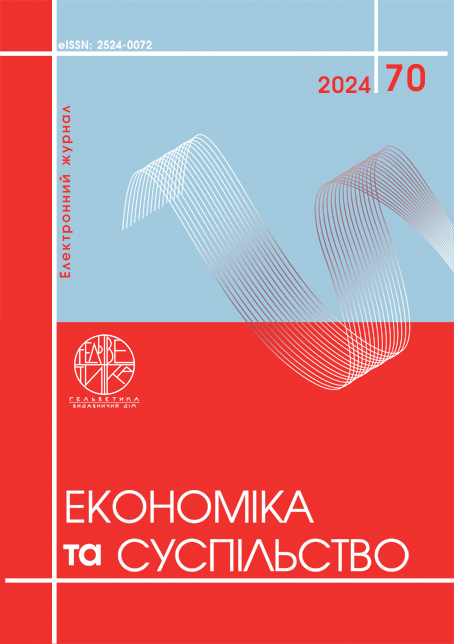SPECIFICS OF PUBLIC ORGANIZATION IMAGE FORMATION
Abstract
In an era of rapid digitalization, increasing information density, and heightened demands for transparency, public organizations are compelled to actively work on building a recognizable and positive image. This process requires a comprehensive approach that takes into account the social context, the specific activities of the organization, and the dynamics of changes in public sentiment. The creation of trust in an organization, attracting new partners, and increasing its influence are achievable only through effective image management. However, many public organizations lack a systematic approach to shaping their identity, one that considers the specifics of social activities, the characteristics of their target audience, and the fluidity of the information space. This creates risks of losing trust, diminishing influence, and limiting opportunities for partnerships. At the same time, traditional marketing strategies often fail to align with social realities, highlighting the need for the development of tailored approaches that integrate elements of social marketing, branding, and communication. These tailored strategies are essential for public organizations to effectively communicate their mission and values to their stakeholders. Exploring this topic offers valuable insights into ways that public organizations can strengthen their role in addressing pressing societal issues and ensure long-term public support. By leveraging innovative approaches to branding and social marketing, public organizations can enhance their impact, foster trust, and build sustainable partnerships with the communities they serve. Such efforts are particularly relevant in today’s interconnected world, where public perception is shaped not only by traditional media but also by the fast-paced digital environment. A strategic focus on image management and public engagement can help public organizations navigate these challenges and solidify their position as trustworthy and effective contributors to societal progress.
References
Дячук М., Буга Н. Формування і підтримка іміджу підприємства. Науковий вісник МНУ імені В. О. Сухомлинського. 2017. № 2 (9). С. 12-16.
Гончаренко А. «Скільки коштує репутація та як її обчислити». Бізнес. 2014. № 17. с. 41 - 45.
Ліфінцев Д. С. Трансляція цінностей корпоративної культури як інструмент формування іміджу компанії. Бізнес Інформ. 2014. № 12. с. 440 – 443
Левкіна Р. В., Левкін А. В. Імідж підприємств на ринку екологічно чистої продукції. Актуальні проблеми інноваційної економік, 2016. № 2. с. 67 - 70.
Економічна енциклопедія: У трьох томах. / Редкол.: С. В. Мочерний та ін. К.: Видавничий центр «Академія», 2000. Т. 2. 864 с
Булгакова О.В. Бренд-імідж підприємства на споживчому ринку. Науковий вісник Ужгородського національного університету. 2017. Вип. 13. Ч.1. С. 31-36.
Ясінська Ю. Р. Корпоративна культура як основа формування іміджу та репутації підприємства. Вісник Львівської комерційної академії. Серія: економічна. 2015. №49. с. 264 - 269.
The Global RepTrak™ 100: A Study of the World’s Most Reputable Companies in 2011. Reputation Institute. – 2011
Трач О. Ю., Карий О. І. Імідж, бренд та репутація: їх взаємозв’язок і вплив на розвиток територій, організацій та окремих осіб. Вісник Національного університету «Львівська політехніка». 2011. №706: Логістика. с. 182 – 187.
Никифоренко В., Кравченко В. Роль іміджу в створенні конкурентних переваг підприємства. Науковий вісник Одеського національного економічного університету. 2017. №4. с. 69-83
Одінцева С. В., Артеменко Л. П. Формування іміджу підприємства: світовий та вітчизняний досвід. URL: http://ape.fmm.kpi.ua/article/view/130972
Котлер Ф., Келлер К. Л., Павленко А. Ф. та ін. Маркетинговий менеджмент : підручник. Київ : Видавництво «Хімджест», 2008. 720 с
Arli, D., Grace, A., Palmer, J., & Pham, C. (2017). Investigating the direct and indirect effects of corporate hypocrisy and perceived corporate reputation on consumers’ attitudes toward the company. Journal of Retailing and Consumer Services, 37, 139–145. https://doi.org/https://doi.org/10.1016/j.jretconser.2017.04.002
Cameron K., Quinn R. (2006) Diagnosing and changing organizational culture / based on competing framework.(revised ed.) San Francisco: Jossey-Bass. 242pp
Bagozzi, R.P. (1981). Attitudes, intentions, and behavior: A test of some key hypotheses. Journal of Personality and Social Psychology, 41, 607–627.
Dyachuk M., Buga N. Formation and support of the image of the enterprise. Scientific Bulletin of V. O. Sukhomlynskyi Mykolaiv National University. Economic sciences. 2017. No. 2 (9). P. 12-16.
Honcharenko A. "How Much Reputation Costs and How to Calculate It." Business, 2014, No. 17, pp. 41–45.
Lifintsev D. S. Transmission of Corporate Culture Values as a Tool for Shaping the Company's Image. Business Inform, 2014, No. 12, pp. 440–443.
Levkina R. V., Levkin A. V. Image of Enterprises in the Market of Environmentally Friendly Products. Actual Problems of Innovative Economy, 2016, No. 2, pp. 67–70.
Economic Encyclopedia: In Three Volumes. / Editorial board: S. V. Mochernyi et al. Kyiv: Publishing Center "Academy," 2000. Vol. 2, 864 p.
Bulgakova O.V. Brand image of an enterprise in the consumer market. Scientific Bulletin of Uzhhorod National University. 2017. Issue 13. Part 1. P. 31-36.
Yasinska Y. R. Corporate Culture as the Basis for Shaping the Image and Reputation of an Enterprise. Bulletin of Lviv Commercial Academy. Series: Economics, 2015, No. 49, pp. 264–269.
The Global RepTrak™ 100: A Study of the World’s Most Reputable Companies in 2011. Reputation Institute, 2011.
Trach O. Yu., Karyi O. I. Image, Brand, and Reputation: Their Interrelation and Impact on the Development of Territories, Organizations, and Individuals. Bulletin of the National University "Lviv Polytechnic," 2011, No. 706: Logistics, pp. 182–187.
Nykyforenko V., Kravchenko V. The Role of Image in Creating Competitive Advantages of an Enterprise. Scientific Bulletin of Odesa National Economic University, 2017, No. 4, pp. 69–83.
Odintseva S. V., Artemenko L. P. Formation of the Enterprise's Image: Global and Domestic Experience. URL: http://ape.fmm.kpi.ua/article/view/130972
Kotler F., Keller K. L., Pavlenko A. F., etc. Marketing Management: Textbook. Kyiv: Publishing House "Khimdzhest", 2008. 720 p.
Arli, D., Grace, A., Palmer, J., & Pham, C. (2017). Investigating the direct and indirect effects of corporate hypocrisy and perceived corporate reputation on consumers’ attitudes toward the company. Journal of Retailing and Consumer Services, 37, 139–145. https://doi.org/https://doi.org/10.1016/j.jretconser.2017.04.002
Cameron K., Quinn R. (2006) Diagnosing and changing organizational culture / based on competing framework.(revised ed.) San Francisco: Jossey-Bass. 242pp
Bagozzi, R.P. (1981). Attitudes, intentions, and behavior: A test of some key hypotheses. Journal of Personality and Social Psychology, 41, 607–627.

This work is licensed under a Creative Commons Attribution 4.0 International License.


